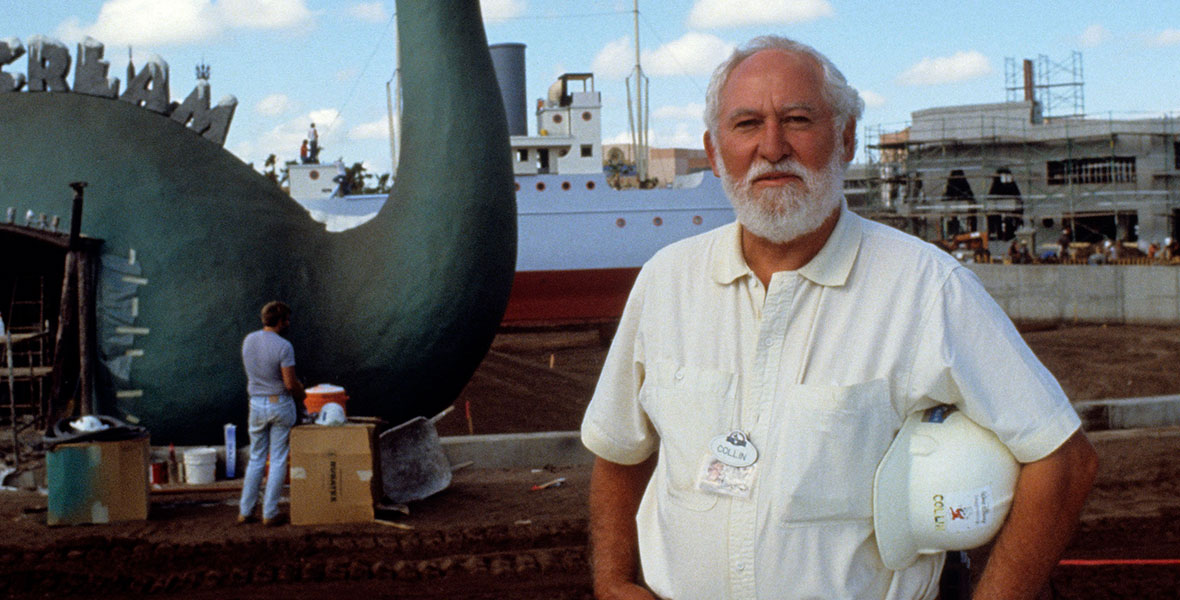Born November 11, 1926, in St. Charles, Michigan, Collin Campbell was a farm boy who found his way to California. He attended half-day sessions at Glendale’s Hoover High School while working on the Disney lot, where he started as a messenger in 1943. In 1944, at the age of 17, he was drafted into the Navy where he would serve for two years. Ironically, he would be assigned into a unit alongside fellow Disney mail clerk and future artist and Disney Legend Walt Peregoy.
Collin returned briefly to the Studio’s Traffic Department after he left the service in 1946, but soon resigned to spend four years at the School of Allied Arts in Glendale, California. To put himself through school, he worked at the campus art store and took custom framing jobs.
After five months back at Disney in 1952, where he worked as an apprentice inbetweener for the Animation Department, Collin left again to spend a year in Paris. In November 1953, he returned to the Studio to stay. He began work as an inbetweener, but soon switched to the Layout Department as an apprentice. There, he worked on such projects as Lady and the Tramp (1955), The Truth About Mother Goose (1957), Sleeping Beauty (1959), Donald in Mathmagic Land (1959), Goliath II (1960), and One Hundred and One Dalmatians (1961). Collin also contributed layout and backgrounds for Ward Kimball’s groundbreaking “Man in Space” episodes for Walt’s Disneyland television program.
His contributions reached beyond animated productions. Working with art director Bruce Bushman, Collin designed many of the iconic sets for the Mickey Mouse Club (1955) including the Mouseketeer Treasure Mine and Dry Gulch, site of the weekly “Talent Roundup.” He contributed costume sketches for live-action productions, and did matte and developmental work with artist Peter Ellenshaw for projects like The Light in the Forest (1958) and Darby O’Gill and the Little People (1959).
Collin then started at WED Enterprises (now Walt Disney Imagineering), which was gearing up production on a slate of attractions for the 1964–65 New York World’s Fair. It wasn’t the first work he’d done for WED, though; as early as 1954 he had helped create paintings of concept art to help sell the park to financiers.
Collin’s first full-time assignment was the Enchanted Tiki Room, which he helped develop.
For the World’s Fair he sculpted cavemen for Ford’s Magic Skyway, built models and sets for It’s a Small World, and designed concept art for the Carousel of Progress. With Claude Coats he developed Pirates of the Caribbean at Disneyland; Collin built the model for the attraction’s Blue Bayou area and designed its trademark flat-bottomed boats. At the same time he helped design the fabled Club 33, for which he hand-painted a scene of the Mississippi River and Jackson Square on the inside lid of Lillian Disney’s harpsichord.
Collin even contributed the spooky illustrations for the beloved “The Story and Song from the Haunted Mansion” album book (1969), which became a favorite keepsake for generations of Disneyland fans.
For Walt Disney World in Florida, Collin developed much of the overall feel for the resort and Magic Kingdom Park. He created concept art for the resort hotels, the Fort Wilderness Railroad, and unbuilt concepts for Treasure Island. He also served as field art director on Tom Sawyer Island, and designed the unique entrance and queue for Florida’s Pirates of the Caribbean attraction.
Later work included renderings and concept art for the Disney-MGM Studios Theme Park (now Disney’s Hollywood Studios) and illustrations of a proposed 1920s-era Main Street, U.S.A. for Disneyland Paris. After serving as art director for Disney’s Typhoon Lagoon water park, Collin retired in 1990—only to return to supervise a renovation of Tom Sawyer Island at Disneyland.
Collin passed away in Lighthouse Point, Florida, on April 2, 2011.



